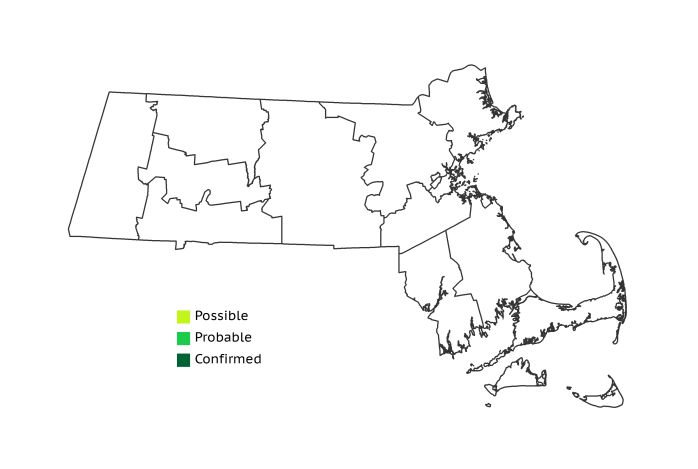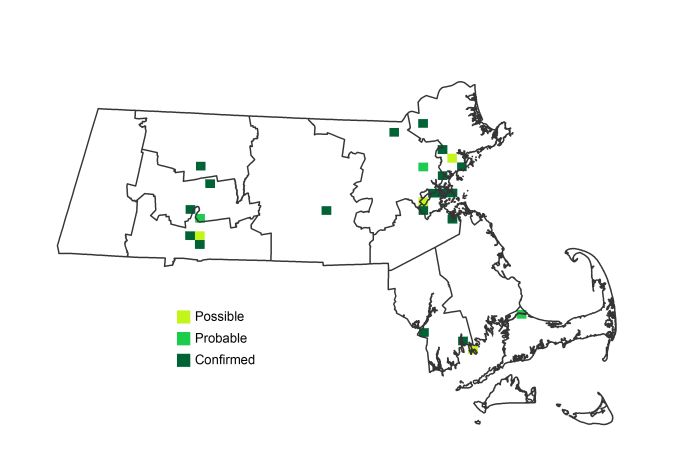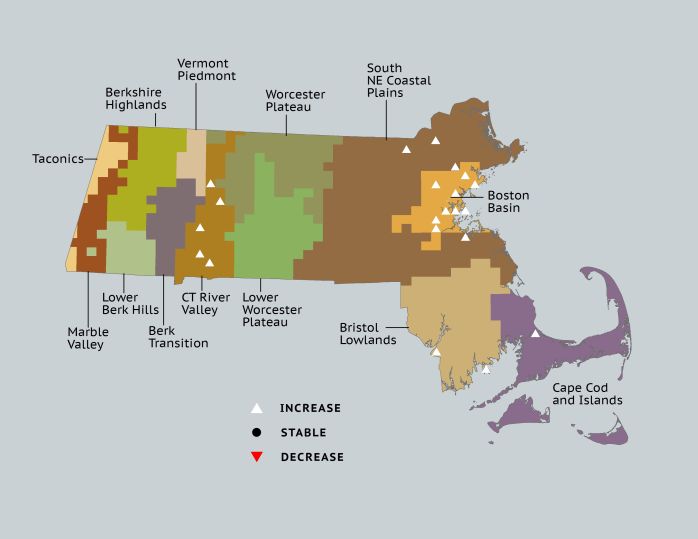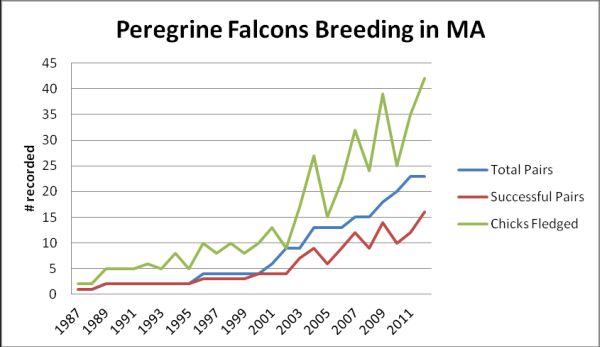Find a Bird
Peregrine Falcon
Falco peregrinus

Local and strongly increasing
Endangered Species

“The quality of decision is like the well-timed swoop of a falcon which enables it to strike and destroy its victim.” – Sun Tzu, The Art of War
Peregrine Falcons in a full stoop are the fastest animals in the world, capable of reaching speeds over 200 mph. This bird’s incredible speed, predatory mien, and global range have made it something of a symbol of the many untamed wilderness areas still remaining on planet Earth. Almost as remarkable as the speed at which it can dive was the speed at which it disappeared from many parts of its traditional breeding range in the 1940s and 1950s. A program to reestablish this species in Massachusetts has met with heartening success, and is one of the great conservation stories of the 20th century.
Historic Status
“In the list of birds of prey,” wrote William Peabody in 1839, “I have not included the Great-footed Hawk, Falco peregrinus, not having ascertained that any one has been taken here.” Taken or not, the species soon to be known as the Duck Hawk and later as the Peregrine Falcon became at least a rarity in Massachusetts within the next 30 years. C.W. Bennett found the first known nest of the species in Massachusetts on Mount Tom in 1864, and thereafter they were known to breed “on Mts. Holyoke, Toby, and Sugarloaf, and probably on other of the western mountains,” (Howe & Allen 1901). By the 1920s, Edward Howe Forbush claimed, "The breeding places in New England now known number less than 40, but there are many cliffs in northern New England suitable for nesting," (Forbush 1927). In the 1930s and 1940s, fourteen known pairs nested in Massachusetts. In 1948, state ornithologist Archie Hagar discovered that a nesting pair on the Quabbin Reservoir had inexplicably broken their own eggs, a moment that was to become the first indicator of the effects of organochlorine pesticides on birdlife. The last nesting pair in Massachusetts was found in 1955 on Monument Mountain in Great Barrington. By 1966, there were no Peregrine Falcons nesting anywhere in the eastern half of the United States (NHESP 2007).
Atlas 1 Distribution
The only wild Peregrine Falcons spotted in Massachusetts during the first Atlas period were migrants, and even those had become decidedly uncommon due to the ravages wrought by DDT. A few birds were released from a captive breeding program at Mount Tom during the late 1970s, but they failed to establish a viable wild population. It would not be until the inter-Atlas period that special nest towers, called hacking towers, were used for hand raising hatchling falcons, and this would host the first real successes at repatriation of Peregrine Falcons to the Bay State and elsewhere (Petersen & Meservey 2003).
Atlas 2 Distribution and Change
Wild Peregrine Falcons were already building on the successes of the hacking program during Atlas 2, with breeding Peregrines present in several ecoregions. The largest centers of breeding activity were invariably focused around major urban areas where tall buildings act like the peregrine’s natural cliff nesting aeries – the city of Springfield in the south of the Connecticut River Valley accounted for three occupied blocks, and the sizable settlements farther north along the river hosted several additional pairs. Confirmed blocks in the Coastal Plains corresponded to other urban areas – Worcester, Lowell, Lawrence – each of which offered tall buildings to serve as surrogate cliffs, as well as an abundance of pigeons to eat. The Boston Basin had more occupied blocks than any other region, and Boston continues to host a sizable population of breeding Peregrine Falcons. Peregrines also gained a hold in the Bristol/Narragansett Lowlands and the upper section of Cape Cod and the Islands, hopefully foreshadowing further expansion in years to come.
Atlas 1 Map

Atlas 2 Map

Atlas Change Map

Ecoregion Data
Atlas 1 | Atlas 2 | Change | ||||||
Ecoregion | # Blocks | % Blocks | % of Range | # Blocks | % Blocks | % of Range | Change in # Blocks | Change in % Blocks |
Taconic Mountains | 0 | 0.0 | 0.0 | 0 | 0.0 | 0.0 | 0 | 0.0 |
Marble Valleys/Housatonic Valley | 0 | 0.0 | 0.0 | 0 | 0.0 | 0.0 | 0 | 0.0 |
Berkshire Highlands | 0 | 0.0 | 0.0 | 0 | 0.0 | 0.0 | 0 | 0.0 |
Lower Berkshire Hills | 0 | 0.0 | 0.0 | 0 | 0.0 | 0.0 | 0 | 0.0 |
Vermont Piedmont | 0 | 0.0 | 0.0 | 0 | 0.0 | 0.0 | 0 | 0.0 |
Berkshire Transition | 0 | 0.0 | 0.0 | 0 | 0.0 | 0.0 | 0 | 0.0 |
Connecticut River Valley | 0 | 0.0 | 0.0 | 7 | 10.8 | 28.0 | 5 | 10.4 |
Worcester Plateau | 0 | 0.0 | 0.0 | 0 | 0.0 | 0.0 | 0 | 0.0 |
Lower Worcester Plateau | 0 | 0.0 | 0.0 | 0 | 0.0 | 0.0 | 0 | 0.0 |
S. New England Coastal Plains and Hills | 0 | 0.0 | 0.0 | 5 | 1.8 | 20.0 | 4 | 1.8 |
Boston Basin | 0 | 0.0 | 0.0 | 9 | 16.1 | 36.0 | 9 | 16.4 |
Bristol and Narragansett Lowlands | 0 | 0.0 | 0.0 | 3 | 2.6 | 12.0 | 2 | 2.0 |
Cape Cod and Islands | 0 | 0.0 | 0.0 | 1 | 0.7 | 4.0 | 1 | 0.8 |
Statewide Total | 0 | 0.0 | 0.0 | 25 | 2.4 | 100.0 | 21 | 2.5 |
Notes
Included are the results of annual surveys for nesting Peregrine Falcons by the Natural Heritage and Endangered Species Program, Massachusetts Division of Fisheries and Wildlife, noting their impressive success with repatriating this species.




